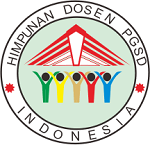PENGGUNAAN APLIKASI GOOGLE CLASSROOM UNTUK MOTIVASI DAN HASIL BELAJAR MATERI GEREJA SEBAGAI UMAT ALLAH PADA SISWA KELAS XI IPA SMAN 1 SIBORONGBORONG SEMESTER 1 TAHUN PELAJARAN 2021/2022
DOI:
https://doi.org/10.24114/jgk.v7i2.45659Keywords:
Google Classroom, Motivation, Learning Outcomes, Materials for the Church of the People of GodAbstract
This study aims to: 1) To find out an increase in motivation to study Catholic religious education on church material as God's people in class XI IPA students at SMAN 1 Siborongborong Semester 1 Academic Year 2021/2022 through the use of an application based on google classroom. 2) To find out the learning outcomes of Catholic religious education on church material as God's people in class XI IPA students of SMAN 1 Siborongborong Semester 1 of the 2021/2022 Academic Year through the use of a google classroom-based application. This research method uses classroom action research (CAR). The research subjects were students of Class XI IPA at SMAN 1 Siborongborong. The data collection technique uses: 1) observation; 2) Test; 3) Documentation. The results of the study show that: 1) The use of a google classroom-based application for learning Catholic religious education for church materials as God's people can increase student motivation. This is evidenced by an increase in learning motivation from 6 students or 26.09% in the initial study to 15 students or 65.22% in the first cycle and 21 students or 91.30% in the last cycle. 2) The use of google classroom-based applications for learning church materials as God's people can improve student learning outcomes. This is evidenced by the increase in the average initial study learning outcomes of 54.78, in the first cycle the average value obtained by students was 66.52 and in the second cycle the average value obtained by students was 74.78 and was supported by an increase learning completeness in the initial state was 4 students (17.39%), in cycle I it increased to 12 students or 52.17% and in cycle II it increased again to 20 students or 86.96%.References
Alimuddin.Tawany Rahamma, dan M. Nadjib. 2015. Intensitas Penggunaan E-Learning Dalam Menunjang Pembelajaran Mahasiswa Program Sarjana Di Universitas Hasanuddin. Skripsi Tidak Diterbitkan
Bilfaqih, Y., Qomarudin, M.N., 2015. Esensi Penyusunan Materi Daring Untuk Pendidikan Dan Pelatihan. Yogyakarta: DeePublish
Eko Kuntarto 2017. Kefektifan Model Pembelajaran Daring Dalam Perkuliahan Bahasa Indonesia Diperguruan Tinggi Journal Indonesian Language Education and Literature / ILE&E/Vol.3 No. 1
Eliningsih. 2021. œPeningkatan Kemampuan Guru Dalam Manajemen Pengelolaan Kelas Di Masa Pandemi Covid-19 Melalui Supervisi Klinis Pengawas Di SDN 15 Perawang. Nuansa Akademik: Jurnal Pembangunan Masyarakat 6(1):25“36
Hardiyana, Andri. 2015. Implementasi Google Classroom sebagai Alternatif dalam Meningkatkan Mutu Pembelajaran di Sekolah. Karya Tulis Ilmiah, Cirebon : SMA Negeri 1 Losari.
Kartika, A. R. 2018. Model Pembelajaran Daring. Journal of Early Childhood Care & Education
Mastoah, Imas, dan Zulaela MS. 2020. œKendala Orang Tua Dalam Mendampingi Anak Belajar Pada Masa Covid 19 Di Kota Serang. As Sibyan: Jurnal Pendidikan Anak Usia Dini 5(2):121“28.
Permendikbud No. 109/2013
Putra, A. P. (2021). Efektifitas Pembelajaran Online Selama Pandemi Covid-19, Metode Dan Evaluasi. Intersections, 6(1), 13“22.
Setyowati, Erna, Ika Septi Hidayati, dan Toto Hermawan. 2020. œPengaruh Penggunaan Multimedia Interaktif Terhadap Pemahaman Konsep Dalam Pembelajaran Matematika Di MTs Darul Ulum Muhammadiyah Galur. Intersections 5(2):26“37. doi: 10.47200/intersections.v5i2.553.
Surur, A. M., & Nadhirin, A. U. (2020). Manajemen Waktu Pembelajaran Daring Di Masa Pandemi Covid-19 Pada TK Dharma Wanita 1 Baleturi. As-Sibyan: Jurnal Pendidikan Anak Usia Dini, 5(2).
Downloads
Published
How to Cite
Issue
Section
License
Authors published with the JGK (Jurnal Guru Kita) agree to the following terms:
- Authors retain copyright and grant the journal the right of first publication with the work simultaneously licensed under a Creative Commons Attribution License (CC BY-SA 4.0) that allows others to share the work with an acknowledgment of the work's authorship and initial publication in this journal.
- Authors are able to enter into separate, additional contractual arrangements for the non-exclusive distribution of the journal's published version of the work (e.g., post it to an institutional repository or publish it in a book), with an acknowledgment of its initial publication in this journal.
- Authors are permitted and encouraged to post their work online (e.g., in institutional repositories or on their website) prior to and during the submission process, as it can lead to productive exchanges, as well as earlier and greater citation of published work. (See The Effect of Open Access)


























